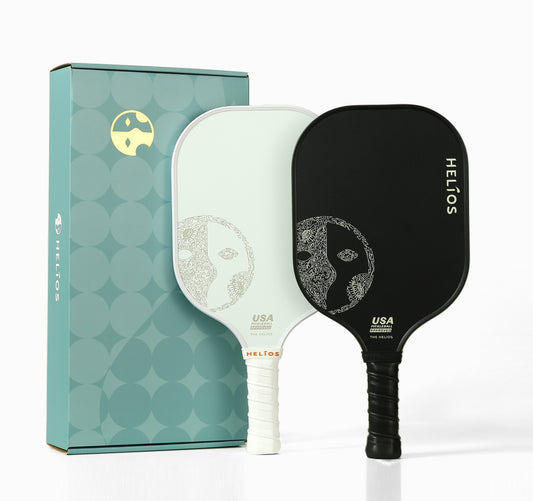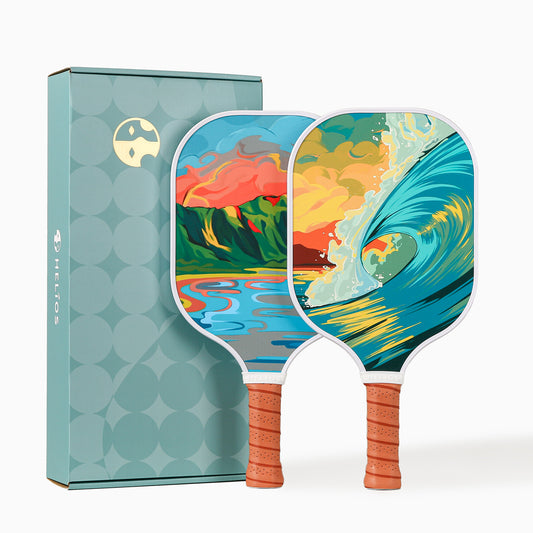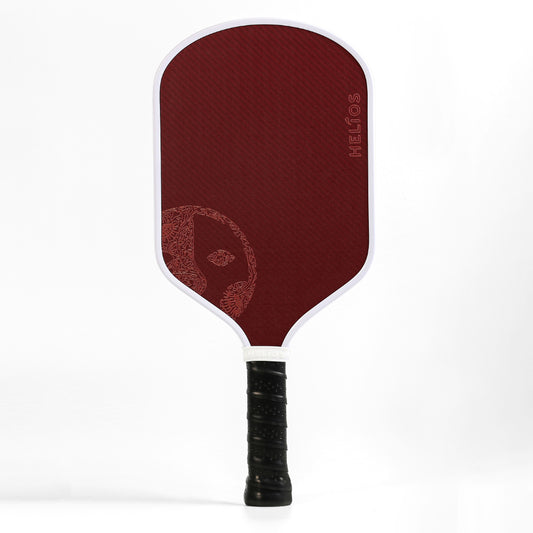How to Choose the Right Pickleball Ball for Indoor vs. Outdoor Play

Introduction: Why Your Pickleball Ball Choice Matters More Than You Think
You've got your paddle, found a court, and are ready to dive into the exciting world of pickleball. But wait, did you know the type of pickleball you use can dramatically impact your game? Many beginners, and even some intermediate players, overlook the significant pickleball ball differences between those designed for indoor versus outdoor environments.
Choosing the right ball isn't just a minor detail; it's crucial for optimal performance, durability, and overall enjoyment of the sport. Understanding how to choose pickleball balls is a fundamental step in equipping yourself for success on the court.
The primary distinction lies in their construction, specifically the pickleball ball hole differences and the pickleball ball material comparison. These design variations directly influence the pickleball ball weight indoor vs outdoor characteristics and, most importantly, the pickleball ball bounce indoor vs outdoor play.
Using an indoor ball on a rough outdoor court or an outdoor ball on a smooth gym floor can lead to a frustrating experience and can even affect your skill development.
Our comprehensive guide will illuminate the key characteristics of both indoor pickleball ball characteristics and outdoor pickleball ball features. We'll explore why these differences exist, how they affect gameplay, and provide you with the knowledge to confidently select the best pickleball balls for outdoor play or indoor matches, ensuring every game you play is with the appropriate equipment. Making the right choice will enhance your control, improve your shot consistency, and allow you to fully appreciate the nuances of this rapidly growing sport.
Understanding the Fundamental Pickleball Ball Differences
At first glance, all pickleballs might look like simple plastic wiffle-style balls. However, a closer inspection reveals critical design variations that distinguish indoor vs outdoor pickleball balls. These differences are not arbitrary; they are specifically engineered to optimize play in their respective environments.
Pickleball Ball Hole Differences: The Core Distinction
The most visually apparent difference lies in the hole patterns. This is a primary factor in the pickleball ball hole differences that dictate performance.
- Outdoor Pickleball Balls: These typically feature more holes, usually around 40, and the holes are generally smaller in diameter. This design helps the ball fly truer in windy conditions, a common challenge in outdoor play. The increased number of smaller holes contributes to a more consistent flight path and reduces the impact of wind gusts. Outdoor balls are often considered the best pickleball balls for outdoor play due to this wind resistance.
- Indoor Pickleball Balls: These balls have fewer, larger holes – commonly 26. The larger holes and reduced number mean indoor balls are less affected by air resistance within a controlled indoor environment. This design contributes to a slightly softer feel and a more predictable bounce on smooth indoor court surfaces like wood or specialized sport courts. The indoor pickleball ball characteristics are tailored for these controlled settings.
Pickleball Ball Material Comparison: Durability and Feel
The plastic used in the construction of indoor vs outdoor pickleball balls also differs significantly, impacting both durability and how the ball feels off the paddle.
- Outdoor Pickleball Ball Features: Outdoor balls are made from a harder, more durable plastic. This robust construction is necessary to withstand the rougher surfaces of outdoor courts (like asphalt or concrete) and the increased wear and tear from environmental factors such as UV exposure and temperature fluctuations. The harder plastic also contributes to a faster game and a louder sound upon impact.
- Indoor Pickleball Ball Characteristics: Indoor balls are typically made from a softer plastic compound. This softer material provides a better bounce on smooth indoor surfaces and generally results in a quieter game. However, this softer plastic is less durable and can crack or become misshapen more easily if used on abrasive outdoor courts.
A thorough pickleball ball material comparison reveals that the choice of plastic is a key element in defining the ball's intended use and overall performance.
How Design Affects Play: Indoor vs Outdoor Pickleball Balls in Action
The structural and material pickleball ball differences translate directly into how each type of ball performs during a game.
Pickleball Ball Weight Indoor vs Outdoor
While official regulations specify a weight range (0.78 to 0.935 ounces), there are subtle but impactful pickleball ball weight indoor vs outdoor tendencies:
- Outdoor Pickleball Balls: Tend to be slightly heavier. This added weight, combined with their hole pattern and harder plastic, helps them maintain stability in windy conditions and provides a more powerful feel off the paddle. The outdoor pickleball ball features are geared towards resisting external elements.
- Indoor Pickleball Balls: Are often on the lighter side of the acceptable range. This lighter weight, coupled with their design, allows for more finesse and a softer touch, which is often preferred for the more controlled environment of indoor play.
Pickleball Ball Bounce Indoor vs Outdoor
The bounce is a critical performance aspect directly influenced by the ball's design. The pickleball ball bounce indoor vs outdoor is noticeably different:
- Outdoor Pickleball Balls: Due to their harder plastic, outdoor balls generally have a lower, faster bounce, especially on hard outdoor courts. They tend to skid more, which can make for a quicker-paced game.
- Indoor Pickleball Balls: The softer plastic of indoor balls typically results in a higher, truer, and more predictable bounce on smooth indoor surfaces. This can make the game feel a bit slower and more controlled compared to outdoor play.
Understanding these bounce characteristics is essential when learning how to choose pickleball balls for your specific playing environment.
Durability and Lifespan
The intended playing surface greatly impacts the lifespan of a pickleball:
- Outdoor Pickleball Balls: Engineered for durability, these balls can withstand the abrasive nature of outdoor courts for a reasonable period. However, they will eventually crack, especially in colder temperatures, or become out-of-round with heavy use.
- Indoor Pickleball Balls: Are much less durable on rough surfaces. Using an indoor ball outdoors will quickly lead to scuffs, cracks, and a loss of roundness. When used exclusively indoors, they can last for a considerable time but may soften over extended play.
Key Outdoor Pickleball Ball Features to Look For
When selecting the best pickleball balls for outdoor play, prioritize these features:
- Hole Pattern: Look for balls with approximately 40 smaller, consistently drilled holes. This is a hallmark of good outdoor pickleball ball features.
- Hardness: The plastic should feel relatively hard and less pliable. This contributes to durability and a consistent bounce on outdoor surfaces.
- Weight: Opt for balls that feel substantial, typically towards the heavier end of the regulation spectrum, to combat wind.
- Seam Quality: A smooth, well-fused seam is indicative of better manufacturing quality and contributes to a truer flight.
- Color: Bright colors like yellow, orange, or lime green are generally preferred for outdoor play as they offer better visibility against various backgrounds and in different lighting conditions.
Many experienced players have their preferred brands for outdoor play, often citing consistency in bounce and durability as key factors. While not a ball, the engineering principles behind a durable paddle like the Helios Athos, with its Kevlar and carbon fiber construction, highlight the importance of material science in sports equipment designed for demanding conditions.
Essential Indoor Pickleball Ball Characteristics
For indoor play, the ideal ball will have different attributes:
- Hole Pattern: Typically 26 larger, uniformly spaced holes are characteristic of indoor pickleball ball characteristics.
- Softness: The plastic should be noticeably softer and more flexible than an outdoor ball. This allows for better control and a softer feel on indoor courts.
- Bounce Consistency: The ball should provide a true and predictable bounce on smooth gym floors or specialized indoor court surfaces.
- Sound: Indoor balls are generally quieter upon impact, which can be preferable in shared indoor facilities.
- Color: While bright colors are still good, some indoor facilities may have specific color preferences to contrast with their court and wall colors. White or orange are common choices.
The controlled environment of indoor play allows for a ball designed more for touch and finesse. Just as a paddle like the Helios Selene is designed for precision and control, indoor balls complement this style of play.
How to Choose Pickleball Balls for Your Game
Making the right selection when learning how to choose pickleball balls involves considering several factors beyond just the indoor/outdoor designation.
Consider Your Primary Playing Environment
This is the most crucial factor.
- If you play exclusively outdoors, invest in several tubes of quality outdoor pickleball balls.
- If you only play indoors, focus on indoor pickleball ball characteristics.
- If you play in both environments, it's essential to have dedicated sets of balls for each. Do not use indoor balls outdoors, as they will wear out very quickly. While outdoor balls can be used indoors, they will play much faster and harder, and the sound can be disruptive.
Skill Level and Play Style
While less critical than the environment, your skill level might subtly influence your preference:
- Beginners: Might initially find the slightly slower play of indoor balls (even if playing outdoors with an outdoor ball that feels "slower" than a very hard one) a bit more forgiving as they learn control. However, it's always best to use the ball designed for the environment.
- Advanced Players: Often develop preferences for specific brands or models within the indoor/outdoor categories based on subtle differences in feel, bounce, and speed.
Temperature and Weather Conditions
Temperature can affect ball performance, especially for outdoor pickleball ball features:
- Cold Weather: Outdoor balls can become even harder and more brittle in cold temperatures, increasing the likelihood of cracking. Some players switch to slightly softer outdoor balls or even indoor balls if playing casually in very cold (but dry) outdoor conditions, though this is not ideal for serious play.
- Hot Weather: Balls may soften slightly in extreme heat, which can affect their bounce and speed.
Sanctioned Tournament Play
If you plan to play in USAPA-sanctioned tournaments, you must use balls that are on the official USAPA approved ball list. This list includes both indoor and outdoor models from various manufacturers. Always check the current list if tournament play is a goal.
Pickleball Ball Material Comparison In-Depth
A deeper dive into pickleball ball material comparison reveals why the plastics differ:
- Outdoor Ball Polymers: Often use a harder polyethylene or similar copolymer blend. These are chosen for their impact resistance, UV stability, and ability to maintain roundness under stress. The goal is to create a ball that can withstand repeated impact on hard surfaces and resist warping from sun exposure.
- Indoor Ball Polymers: Typically use a softer, more flexible ethylene-vinyl acetate (EVA) blend or a softer polyethylene. These materials are selected for their ability to provide a consistent bounce on smooth surfaces and for their quieter impact sound. They offer more "give" on impact with the paddle.
The manufacturing process, including the rotational molding technique used for most pickleballs, also plays a role. The precision of the mold, the cooling process, and the way the two halves of the ball are fused at the seam all contribute to the final flight and bounce characteristics. Higher quality balls will have more uniform wall thickness and a smoother, more durable seam.
Longevity and Care of Your Pickleball Balls
To get the most out of your pickleball balls:
- Store Properly: Keep balls out of direct sunlight and extreme temperatures when not in use. Avoid leaving them in a hot car.
- Clean Occasionally: Outdoor balls can pick up dirt and grime. Wiping them with a damp cloth can help maintain their surface.
- Inspect Regularly: Check for cracks, especially around the seam and holes. Also, check for out-of-roundness by rolling the ball on a flat surface.
- Rotate Your Stock: If you have multiple balls, rotate their use to ensure even wear.
- Replace When Necessary: Don't try to play with cracked or severely out-of-round balls. They perform unpredictably and can lead to bad habits or frustration. Outdoor balls typically last anywhere from 3-10 games depending on the intensity of play and court surface before they might crack or become too soft. Indoor balls, when used appropriately, can last much longer.
Just as you'd care for a premium paddle like the Helios Gaia to ensure its longevity, giving some attention to your pickleball balls will ensure they perform their best.
Conclusion: Making the Right Choice for Every Game
Choosing between indoor vs outdoor pickleball balls is a fundamental aspect of preparing for a satisfying game. The pickleball ball differences, primarily driven by pickleball ball hole differences and pickleball ball material comparison, are engineered to provide optimal play in specific environments.
Outdoor balls are designed for durability and wind resistance with their harder plastic and more numerous, smaller holes, making them the best pickleball balls for outdoor play. Conversely, indoor balls, with their softer plastic and fewer, larger holes, offer a more controlled and quieter experience suited to smooth indoor surfaces.
Understanding how to choose pickleball balls involves assessing your primary playing location, considering the pickleball ball weight indoor vs outdoor nuances, and appreciating how the pickleball ball bounce indoor vs outdoor will affect your game. Armed with this knowledge, you can confidently select the right ball, ensuring that every dink, drive, and drop shot is supported by equipment designed for the conditions.
While the ball might seem like a small part of your pickleball arsenal, especially when compared to selecting a paddle from a diverse range like the Helios Pickleball paddle collection, using the correct ball is crucial for consistency, skill development, and overall enjoyment of this fantastic sport.
Frequently Asked Questions
Can I use indoor pickleball balls for outdoor play, or vice versa?
You can technically use outdoor balls indoors (they'll be faster and louder) but avoid using indoor pickleball balls outdoors as they will wear out very quickly and crack easily on rough surfaces.
What is the main reason for the different number of holes in indoor and outdoor pickleballs?
The pickleball ball hole differences (typically 26 larger holes for indoor, 40 smaller for outdoor) primarily affect wind resistance. More, smaller holes help outdoor pickleball ball features include better flight stability in windy conditions.
Do indoor and outdoor pickleballs weigh differently?
While both must meet USAPA weight regulations (0.78-0.935 oz), outdoor pickleball balls tend to be slightly heavier to help combat wind. This is a key aspect of the pickleball ball weight indoor vs outdoor consideration.
How does the bounce of an indoor pickleball compare to an outdoor one?
Generally, indoor pickleball ball characteristics include a higher, more predictable bounce on smooth gym floors. Outdoor pickleball balls have a lower, faster, and sometimes skidding bounce on hard courts.
What color pickleball is best for outdoor play?
Bright, highly visible colors like optic yellow, bright orange, or lime green are considered the best pickleball balls for outdoor play as they contrast well with most outdoor court surfaces and sky conditions.






